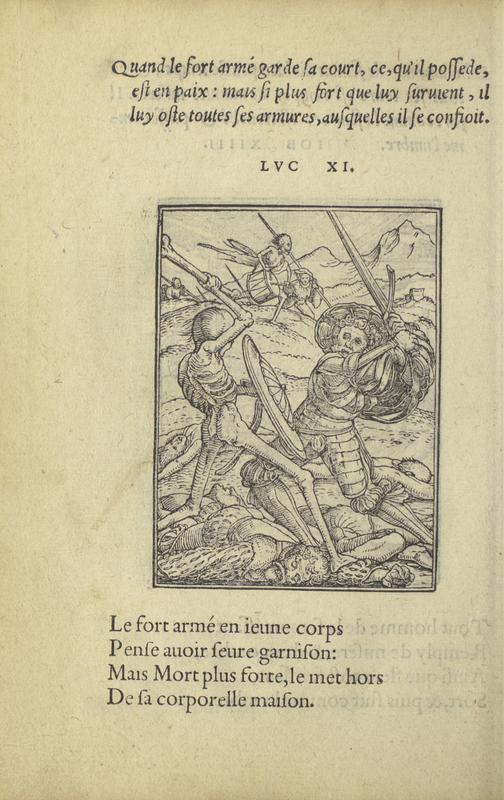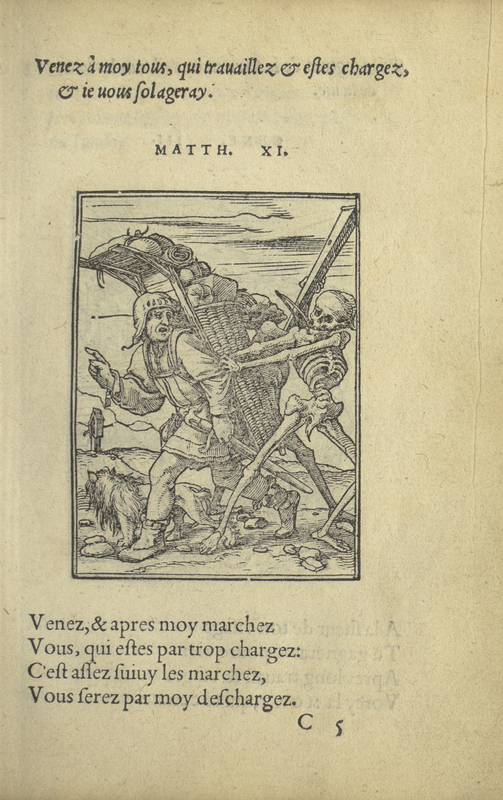Search
-
 Still image
Still imageThe Last Judgement
Holbein, Hans, 1497-1543A woodcut depicting Jesus siting on the earth, surrounded by a cloud of witnesses, for the last judgment. The woodcut is accompanied by verses from Romans 14 and Matthew 28 translated into French (top) and then reformatted into verse (bottom). -
 Still image
Still imageIl partira les despoilles auec les puissans
Holbein, Hans, 1497-1543A woodcut depicting a group of putti (cherubs) displaying the spoils of battle (armor). The woodcut is accompanied by a verse from Isaiah 53 translated into French (top) and then reformatted into verse (bottom). -
 Still image
Still imageCeux qui ont leur uentre pour leur Dieu
Holbein, Hans, 1497-1543A woodcut depicting a group of putti (cherubs) parading with grapes and vines. The woodcut is accompanied by a verse from Philippians 3 translated into French (top) and then reformatted into verse (bottom). -
 Still image
Still imageLes enfans sont trebuchez sur le bois
Holbein, Hans, 1497-1543A woodcut depicting a group of putti (cherubs) returning from a hunt. The woodcut is accompanied by a verse from Lamentations 5 translated into French (top) and then reformatted into verse (bottom). -
 Still image
Still imageIl sera percé da sagettes
Holbein, Hans, 1497-1543A woodcut depicting a putto (cherub) holding a shield and an arrow symbolizing the prohibition given to the Israelites to not go up on the Holy Mountain, or Mount Sinai. The woodcut is accompanied by a verse from Exodus 19 translated into French (top) and then reformatted into verse (bottom). -
 Still image
Still imageThe Beggar
Holbein, Hans, 1497-1543A woodcut depicting an injured beggar sitting outside the house of a wealthy family, who ignore him. The beggar's hands are pressed together in supplication, but Death is not presence to release him from his misery. The woodcut is accompanied by a verse from Romans 7 translated into French (top) and then reformatted into verse (bottom). -
 Still image
Still imageThe Waggoner
Holbein, Hans, 1497-1543A woodcut depicting two skeletons (= Death) destroy a wagon full of wine barrels while the waggoner looks on in distress. The woodcut is accompanied by a verse from 1 Samuel 9 translated into French (top) and then reformatted into verse (bottom). -
 Still image
Still imageThe Blind Man
Holbein, Hans, 1497-1543A woodcut depicting a skeleton (= Death) leading a blind man by his cane. The woodcut is accompanied by a verse from Matthew 15 translated into French (top) and then reformatted into verse (bottom). -
 Still image
Still imageThe Robber
Holbein, Hans, 1497-1543A woodcut depicting a skeleton (= Death) taking hold of a man who is in the proess of robbing a woman who is carrying a basket of goods. The woodcut is accompanied by a verse from Isaiah 38 translated into French (top) and then reformatted into verse (bottom). -
 Still image
Still imageThe Fool
Holbein, Hans, 1497-1543A woodcut depicting a skeleton (= Death) playing the bagpipes as he pulls a fool down the road. The woodcut is accompanied by a verse from Proverbs 7 translated into French (top) and then reformatted into verse (bottom). -
 Still image
Still imageThe Drunkards
Holbein, Hans, 1497-1543A woodcut depicting a skeleton (= Death) pouring wine into the mouth of one of a group of revelers as one of his companions vomits over the side of the table. The woodcut is accompanied by a verse from Ephesians 5 translated into French (top) and then reformatted into verse (bottom). -
 Still image
Still imageThe Gamblers
Holbein, Hans, 1497-1543A woodcut depicting a skeleton (= Death) fighting a demon over one of three gamblers at a table. The woodcut is accompanied by a verse from Matthew 16 translated into French (top) and then reformatted into verse (bottom). -
 Still image
Still imageThe Soldier
Holbein, Hans, 1497-1543A woodcut depicting a skeleton (= Death) dueling a soldier on a battlefields as another skeleton plays a drum in the background. The woodcut is accompanied by a verse from Luke 11 translated into French (top) and then reformatted into verse (bottom). -
 Still image
Still imageThe Young Child
Holbein, Hans, 1497-1543A woodcut depicting a skeleton (= Death) taking a child from their home as their mother is in the process of preparing a meal and another child cries after them. An hourglass, the reminder of human mortality, rests on the floor. The woodcut is accompanied by a verse from Job 14 translated into French (top) and then reformatted into verse (bottom). -
 Still image
Still imageThe Ploughman
Holbein, Hans, 1497-1543A woodcut depicting a skeleton (= Death) driving the team of a ploughman. An hour-glass, representing time, hangs from the skeleton’s neck. The woodcut is accompanied by a verse from Genesis 3 translated into French (top) and then reformatted into verse (bottom). -
 Still image
Still imageThe Peddler
Holbein, Hans, 1497-1543A woodcut depicting a skeleton (= Death) tugging at a fleeing peddler. A lion stands at the feet of the peddler, looking away. The woodcut is accompanied by a verse from Matthew 11 translated into French (top) and then reformatted into verse (bottom). -
 Still image
Still imageThe Duchess
Holbein, Hans, 1497-1543A woodcut depicting two skeletons (= Death) appearing before a duchess in her bed. One skeleton plays the violin, while the other pulls at her bed sheets. The woodcut is accompanied by a verse from 2 Kings 1 translated into French (top) and then reformatted into verse (bottom). -
 Still image
Still imageThe Noblewoman
Holbein, Hans, 1497-1543A woodcut depicting a skeleton (= Death) beating a drum in front of a noble lady and her admirer. An hourglass, the reminder of human mortality, is in the bottom right corner. The woodcut is accompanied by a verse from Ruth 1 translated into French (top) and then reformatted into verse (bottom). -
 Still image
Still imageThe Countess
Holbein, Hans, 1497-1543A woodcut depicting a skeleton (= Death) placing a necklace of bones around the neck of a countess. An hour-glass, representing time, sits on her table. The woodcut is accompanied by a verse from Job 21 translated into French (top) and then reformatted into verse (bottom). -
 Still image
Still imageThe Old Man
Holbein, Hans, 1497-1543A woodcut depicting a skeleton (= Death) leading an old man by the hand into an open grave, while playing an instrument. An hourglass, the reminder of human mortality, is behind them. The woodcut is accompanied by a verse from Job 17 translated into French (top) and then reformatted into verse (bottom). -
 Still image
Still imageThe Count
Holbein, Hans, 1497-1543A woodcut depicting a skeleton (= Death) dressed as a laborer preparing to hit a count with the symbol of his authority: his family coat of arms. The objects and ornaments of his coat of arms are seen scattered on the ground. The woodcut is accompanied by a verse from Psalms 48 translated into French (top) and then reformatted into verse (bottom).